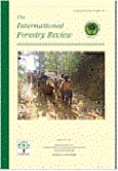The struggle over Asia’s forests: an overview of forest conflict and potential implications for REDD+


The struggle over Asia’s forests: an overview of forest conflict and potential implications for REDD+Asia is a forest conflict hotspot. As natural forests are declining rapidly, their ability to provide economic, ecological, and social benefits is also declining – leading to heightened competition among forest user groups and increased conflict in many parts of the region. A new paper in the International Forestry Review, co-authored by RECOFTC and CIFOR staff, indicates there are three fundamental and interrelated causes underlying most forest conflict in Asia.
This study focuses on conflicts between local communities and outsiders: the underlying causes, conflict management approaches, and eventual outcomes. Field data was collected through interviews and focus group discussions in seven community-outsider conflict cases across five countries.
Actors on the “community” side of the conflicts include shifting cultivators, indigenous people, and local residents in and around forest areas. Local communities are treated as a single entity in the conflict, with the assumption that they face some collective threat from external actors. However, the fact that local communities may not necessarily be homogenous and may have different interests in the conflict is recognized in this study.
On the other side of the conflict are the “outsiders.” These actors vary from place to place and from conflict to conflict. In Asia, there are at least four common actors directly involved in forest management conflicts: logging concessionaires, mining companies, plantation owners and operators, and government conservation agencies
Overlapping statutory and customary tenure was found to be a leading driver of conflict in each of the case studies considered. Different actors use different bases and arguments to legitimize their claims, and the question of whose claim should dictate the proper course of action is delicate. In this situation, the willingness of actors to discuss their differences is key to successful conflict management.
The second driver of conflict was found to be the exclusion of local communities in land use decisions, particularly when land use change resulted in communities being considered illegal settlers when protected areas are created. As long as economic development and conservation-oriented policies exclude local communities as an important partner, conflict will likely continue. Early consultation is an important prerequisite for governments and companies. Fortunately, in many countries there is a growing decentralization process taking place, strengthened by with the increasing presence of civil society. This will hopefully ensure more inclusive land-based development and conservation.
Finally, poor coordination between state agencies contributed to conflict in at least two of the seven cases. In Cambodia, state agencies issued overlapping permits on the same piece of land. Poor coordination resulted in a situation hostile to the development of community forests, and led to forest destruction by mining operations and land clearing for rubber plantation.
The findings give some critical insights as to why managing community-outsider conflict can be so difficult. First, addressing tenure is a challenge in and of itself. Where governments or more powerful actors are flexible in their positions, solutions are possible – including the possibility of co-management. Second, the study suggests that excluding communities from decision-making can result in conflict. Shifting towards a more inclusive means of development and conservation would not only be pragmatic, but also morally imperative. Finally, inter-sectoral coordination must be pursued. Government agencies should work in partnership, rather than in silos.
With renewed global interest in tropical forests to address issues related to climate change, particularly through REDD+, the resource struggles in Asia’s forests may become more daunting. Tenure will be a strong determinant of who benefits from REDD+ and how, and REDD+ will raise many important questions regarding ownership of trees, carbon, and decision-making power. Unless discussed and addressed from the beginning of any development, REDD+ may displace those with customary tenure, inadvertently resulting in new conflict or exaggerating existing conflict.
The findings also suggest that any REDD+ initiative needs to involve communities early and often to understand and accommodate their needs and rights. Consultations allow for the consideration and incorporation of their interests, and increase the effectiveness of conflict management. Participatory processes and transparency should therefore be institutionalized.
Finally, coordination between sectors and integrated land use planning will define the success of REDD+. The case studies suggest that if demand for land for REDD+ is not coordinated with other land demands, forest conflict may increase. Integrated planning across line agencies is rare, and forest development is often initiated by national or international companies with the support of a single government agency. Most countries lack the capacity to track and monitor all land-based developments at the national level. While this study does not focus on REDD+, it points to the need for future research to explore the relationships between forest conflict and REDD+.
This piece was adapted from The struggle over Asia’s forests: an overview of forest conflict and potential implications for REDD+, published in Volume 14 of the International Forestry Review.
Authors: Yasmi, Y.; Kelley, L.; Murdiyarso, D.; Patel, T.
Source: International Forestry Review, Volume 14, Number 1, March 2012 , pp. 99-109(11)

